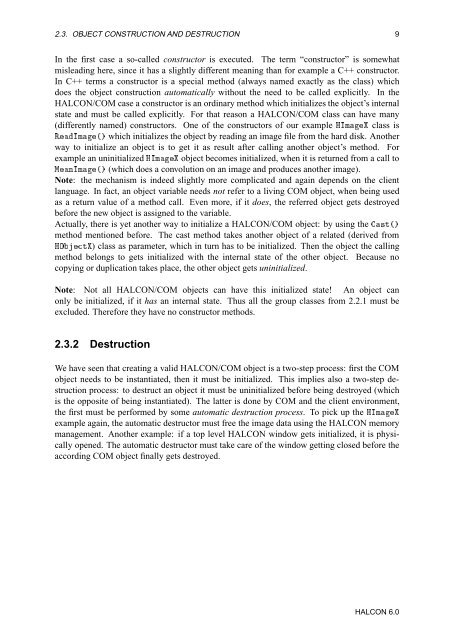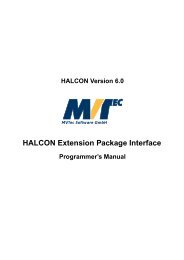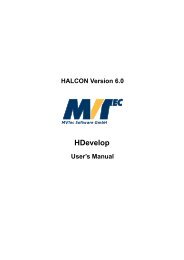HALCON/COM User's Manual
HALCON/COM User's Manual
HALCON/COM User's Manual
Create successful ePaper yourself
Turn your PDF publications into a flip-book with our unique Google optimized e-Paper software.
2.3. OBJECT CONSTRUCTION AND DESTRUCTION 9<br />
In the first case a so-called constructor is executed. The term “constructor” is somewhat<br />
misleading here, since it has a slightly different meaning than for example a C++ constructor.<br />
In C++ terms a constructor is a special method (always named exactly as the class) which<br />
does the object construction automatically without the need to be called explicitly. In the<br />
<strong>HALCON</strong>/<strong>COM</strong> case a constructor is an ordinary method which initializes the object’s internal<br />
state and must be called explicitly. For that reason a <strong>HALCON</strong>/<strong>COM</strong> class can have many<br />
(differently named) constructors. One of the constructors of our example ÀÁÑ class is<br />
ÊÁÑ´µ which initializes the object by reading an image file from the hard disk. Another<br />
way to initialize an object is to get it as result after calling another object’s method. For<br />
example an uninitialized ÀÁÑ object becomes initialized, when it is returned from a call to<br />
ÅÒÁÑ´µ (which does a convolution on an image and produces another image).<br />
Note: the mechanism is indeed slightly more complicated and again depends on the client<br />
language. In fact, an object variable needs not refer to a living <strong>COM</strong> object, when being used<br />
as a return value of a method call. Even more, if it does, the referred object gets destroyed<br />
before the new object is assigned to the variable.<br />
Actually, there is yet another way to initialize a <strong>HALCON</strong>/<strong>COM</strong> object: by using the ×Ø´µ<br />
method mentioned before. The cast method takes another object of a related (derived from<br />
ÀÇØ) class as parameter, which in turn has to be initialized. Then the object the calling<br />
method belongs to gets initialized with the internal state of the other object. Because no<br />
copying or duplication takes place, the other object gets uninitialized.<br />
Note: Not all <strong>HALCON</strong>/<strong>COM</strong> objects can have this initialized state! An object can<br />
only be initialized, if it has an internal state. Thus all the group classes from 2.2.1 must be<br />
excluded. Therefore they have no constructor methods.<br />
2.3.2 Destruction<br />
We have seen that creating a valid <strong>HALCON</strong>/<strong>COM</strong> object is a two-step process: first the <strong>COM</strong><br />
object needs to be instantiated, then it must be initialized. This implies also a two-step destruction<br />
process: to destruct an object it must be uninitialized before being destroyed (which<br />
is the opposite of being instantiated). The latter is done by <strong>COM</strong> and the client environment,<br />
the first must be performed by some automatic destruction process. TopickuptheÀÁÑ<br />
example again, the automatic destructor must free the image data using the <strong>HALCON</strong> memory<br />
management. Another example: if a top level <strong>HALCON</strong> window gets initialized, it is physically<br />
opened. The automatic destructor must take care of the window getting closed before the<br />
according <strong>COM</strong> object finally gets destroyed.<br />
<strong>HALCON</strong> 6.0
















